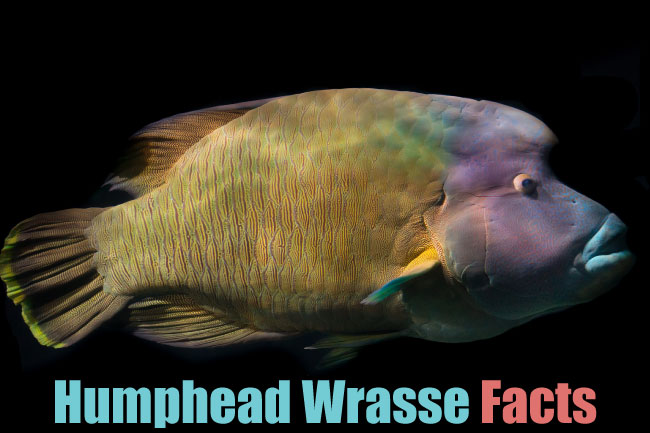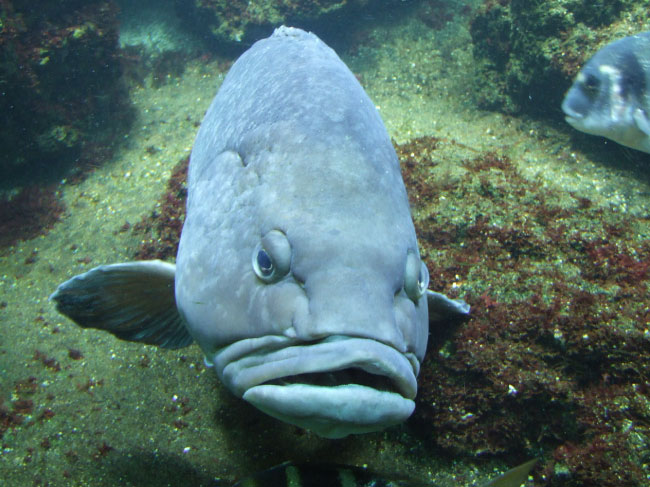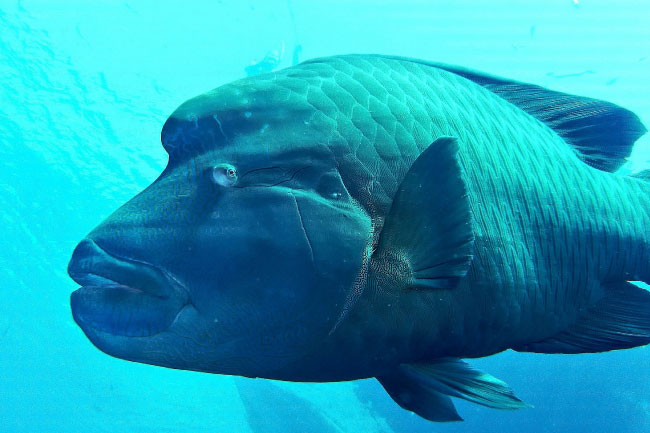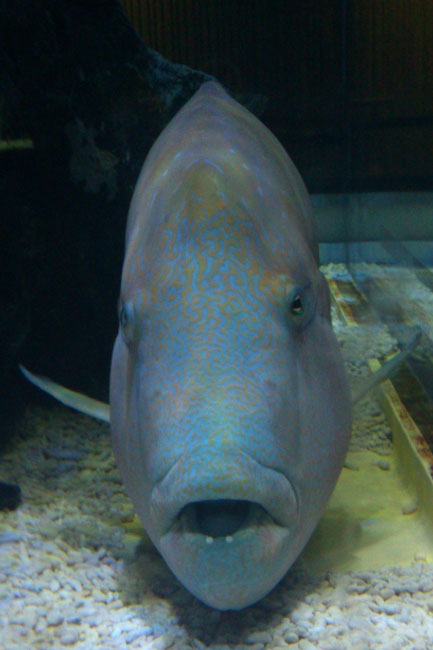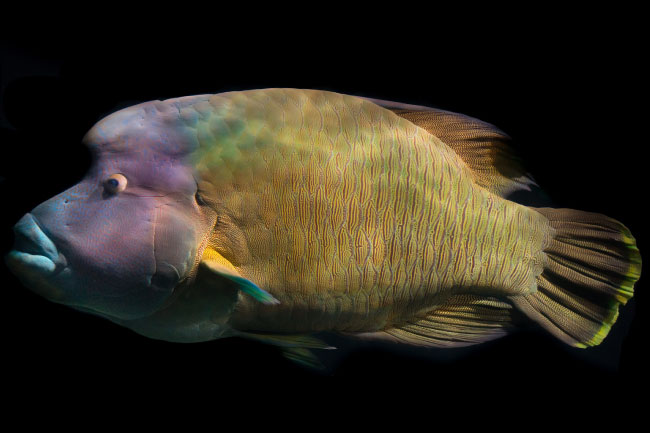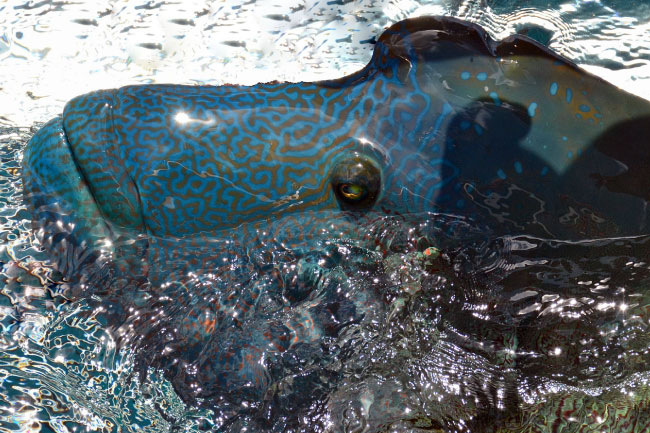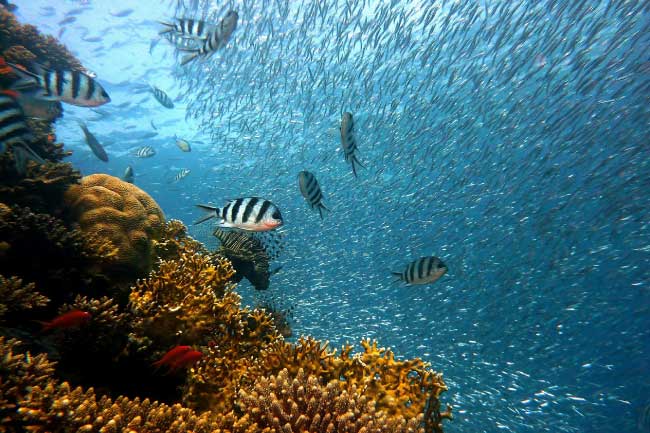Humphead wrasse facts, pictures and information for kids and adults. Learn more about this fascinating endangered reef fish …
- You can find pictures, facts and information about many other endangered animals here: Endangered Animals List.
- Become an animal expert! Visit our main animals page: Animals: The Ultimate Guide.
Humphead Wrasse Quick Facts
- Other Names: Māori wrasse, Napoleon wrasse, Napoleon fish
- Scientific Name: Cheilinus undulatus
- Type of Animal: Bony fish (Osteichthyes)
- Animal Family: Labridae (Wrasse family)
- Where Found: Indo-Pacific region
- Length: 0.5 to 2 m (1.6 feet to 6.7 ft.)
- Weight: Up to 180 kg (400 lb.)
- Conservation Status: Endangered
Humphead Wrasse Facts: Introduction
The humphead wrasse may not be the best-known fish on the reef, and it’s not going to win any beauty contests, but that doesn’t mean that this endangered species doesn’t warrant our attention.
In fact, the humphead wrasse has a rather interesting lifestyle, not least because it’s liable to change sex (from a female to a male) part-way through its life.
On this page, we’ll discover more about the humphead wrasse and why it is currently under threat …
Meet the Humphead Wrasse
The Humphead wrasse is a marine fish that lives on coral reefs in the Indo-Pacific region.
(The Indo-Pacific region includes the Indian Ocean from the east coast of Africa and the western and central regions of the Pacific Ocean.)
The humphead wrasse is the largest member of the Labridae (wrasse) family. There are over 600 species of wrasse. Most, like the humphead wrasse, are found in tropical and subtropical waters.
Watch the video below to see the humphead wrasse in the wild:
You can’t miss an adult humphead wrasse, and not just because of its size. As its name suggests, it has a prominent ‘hump’ on its forehead. Other distinguishing features include extremely big lips and two thin horizontal lines behind its eyes.
The humphead wrasse is usually a blue-green color, but can also occur in a variety of blue, green and purple shades.
Humphead Wrasse Size
The humphead wrasse is one of the world’s largest reef fishes. It grows up to 2 meters (6.5 ft.) in length, and weighs up to 180 kg (400 lb.). Males are larger than females, which rarely exceed 1 m (3.2 ft.) in length.
Behavior
Although the humphead wrasse is found over a wide area, it is not a common sight anywhere within its range. There are rarely more than 10 humphead wrasse found in every hectare of suitable habitat.
Young Humphead wrasses are most often found in shallow sandy areas alongside coral reefs, whereas adults favor deeper areas of the reef. Humphead wrasses retreat to caves and other sheltered areas in the reef during the night.
The humphead wrasse is most often solitary, although it is also seen in male / female pairs and in small groups.
Humphead Wrasse Facts: Diet
The humphead wrasse’s diet consists of mollusks, fish, echinoderms (star fish, sea urchins, etc.) and crustaceans. Its diet includes several toxic species, such as sea hares, boxfish and the crown-of-thorns starfish – a species that is known to destroy coral reefs. (This is one reason why conservation of the humphead wrasse is important).
Humphead Wrasse Life Cycle
Like many wrasses, the humphead wrasse is a protogynous hermaphrodite. In other words, a female that changes into a male.
There are actually two types of male humphead wrasse: initial phase males and terminal phase males. Humphead wrasses are born either as ‘initial phase males’ or females.
At around 9 years old, some of the females turn into initial phase males. It is not known what prompts this change. Some initial phase males then go on to become terminal phase males.
Reproduction
At certain times of the year humphead wrasses gather together in large mating groups which comprise both males and females. There can be over 100 humphead wrasses in these groups.
Pairs form within the group, and mating commences. Mating involves males fertilizing eggs that the female has released into the water.
Humphead Wrasse Lifespan
Humphead wrasses are very long-lived fish. Females can live to around 50 years, and males to around 45 years (although in the wild these figures are significantly reduced). Humphead wrasses reach sexual maturity aged around 5 to 7 years.
Being so large, the humphead wrasse has few natural predators.
Humphead Wrasse Facts: Conservation Status
The humphead wrasse is rated ‘endangered’ by the IUCN. It is also considered to be ‘conservation dependent’, meaning that its survival is currently dependent on human intervention.
The main threat to the humphead wrasse is over-fishing. The species is much sought after, particularly as a live export for the restaurant industry.
One way of catching the humphead wrasse alive is to stun it with cyanide or a similar poisonous substance. The poison is sprayed into the fish’s habitat. The fish is forced to hide in a crevice or hole in the coral and becomes sluggish as the poison takes hold. The fisherman can then easily capture the fish, even breaking away parts of the coral reef in order to reach it.
The fish is taken from the sea and put into a tank containing clean water. Here it recovers, ready to be transported and sold.
The humphead wrasse is specifically targeted in this manner, and is harvested intensively. Because the fish takes several years to reach sexual maturity, intensive fishing can have a devastating effect on the population.
Sadly, the humphead wrasse is a sought-after commodity. It can sell for as much as $100 US dollars per kilogram in some countries. As the species becomes scarcer, its value rises proportionally.
Umbrella Species
The humphead wrasse has been identified by scientists as being an ‘umbrella species’. An umbrella species is a species that plays an important part in a local ecosystem. It is likely that any conservation measures designed to help an umbrella species would also be of benefit to many other species in the ecosystem.
A number of countries now have conservation measures in place to protect the humphead wrasse. Australia gave the fish complete protection in 1998, and in 2003 banned the removal of the species for any purpose other than education and public display.
Other Indo-Pacific countries have also either regulated or banned the hunting/capture and export of the humphead wrasse.
However, the humphead wrasse is still fished for and exported illegally, and the global humphead wrasse population continues to fall.
Habitat Loss
The humphead wrasse is also threatened by habitat loss. It is estimated that a quarter of the world’s coral reefs are irreparably damaged and that another two thirds are under threat. Destructive fishing practices (such as cyanide fishing) are a major factor in the disappearance of coral reefs.
Humphead Wrasse Facts: Conclusion
The plight of the humphead wrasse isn’t as well reported as that of other endangered animals, but this large fish is an important part of the reef ecosystem. We hope that you have enjoyed finding out about this rare reef fish, and are now thinking of ways in which you can help!
- You can find out about more endangered animals here: Endangered Animals List
- Discover the amazing animal kingdom: Animals: The Ultimate Guide
- Become a fish expert: Fish - The Ultimate Guide
- Discover more about fish: Types of Fish with Pictures & Facts
- Know someone who loves fish? Get some gift ideas: Fish Gift Ideas

